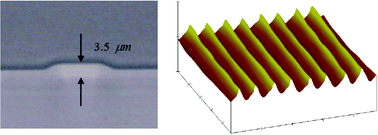Organic–inorganic hybrids were prepared using ureapropyltriethoxysilane, methacryloxypropyltrimethoxysilane and acrylic acid modified zirconium(IV) n-propoxide precursors and were characterized by small angle X-ray scattering, X-ray diffraction and photoluminescence spectroscopy. The results indicate an effective interaction between the zirconium-based nanoparticles and the siliceous nanodomains that induces changes in the hybrids' emission features. Planar waveguides were obtained by spin-coating of the prepared sols on sodalime and silica substrates. Refractive index, thickness, number of propagating modes, and attenuation coefficient were measured at 543.5, 632.8 and 1550 nm by the prism coupling technique. The synergism between the two hybrid precursors resulted in monomode planar waveguides with low losses in the infrared (from 0.6–1.1 dB cm−1) which also support a number of propagating modes in the visible (losses from 0.4–1.5 dB cm−1). Channel waveguides were also obtained by UV photopatterning using amplitude or phase masks and propagating modes were observed at 1550 nm.

You have access to this article
 Please wait while we load your content...
Something went wrong. Try again?
Please wait while we load your content...
Something went wrong. Try again?


 Please wait while we load your content...
Please wait while we load your content...